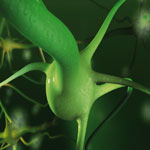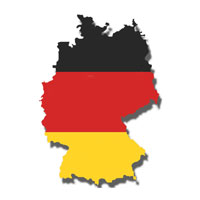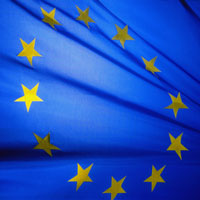Showing Spotlights 9 - 16 of 18 in category All (newest first):
 Nanobiotechnology is essentially different in many aspects from other areas of nanotechnology such as nanoelectronics or nanomaterials. It is certainly the most complex sub-area of nanotechnology. Last month, EuroNanoBio - a Support Action funded under the 7th Framework Programme of the European Union - has issued its report on a conceptual framework and a tool box to structure the European capacity in nanobiotechnology. The EuroNanoBio partners explored the definition, establishment and further development of a European scale infrastructure on nanobiotechnology and the associated realistic implementation plan. It aimed at defining not only the key features of a potential European infrastructure in nanobiotechnology, but it has also established the way it should be designed.
Nanobiotechnology is essentially different in many aspects from other areas of nanotechnology such as nanoelectronics or nanomaterials. It is certainly the most complex sub-area of nanotechnology. Last month, EuroNanoBio - a Support Action funded under the 7th Framework Programme of the European Union - has issued its report on a conceptual framework and a tool box to structure the European capacity in nanobiotechnology. The EuroNanoBio partners explored the definition, establishment and further development of a European scale infrastructure on nanobiotechnology and the associated realistic implementation plan. It aimed at defining not only the key features of a potential European infrastructure in nanobiotechnology, but it has also established the way it should be designed.
Feb 19th, 2010
 Europe is a key player in nanotechnology and, about on the same level as the U.S., invests hundreds of millions of dollars, or rather euros, into nanotechnology research and development projects. Whereas the U.S. National Nanotechnology Initiative (NNI) in was established in 2001 to coordinate Federal nanotechnology research and development, the European Union's slowly grinding bureaucratic mills came up with a comparable program only three years later. In May 2004, the European Commission adopted the Communication Towards a European Strategy for Nanotechnology. It seeks to bring the discussion on nanoscience and nanotechnology to an institutional level and proposes an integrated and responsible strategy for Europe. Since then, the EU has issued updates on how they are doing with two implementation reports, the last one issued just a few days ago.
Europe is a key player in nanotechnology and, about on the same level as the U.S., invests hundreds of millions of dollars, or rather euros, into nanotechnology research and development projects. Whereas the U.S. National Nanotechnology Initiative (NNI) in was established in 2001 to coordinate Federal nanotechnology research and development, the European Union's slowly grinding bureaucratic mills came up with a comparable program only three years later. In May 2004, the European Commission adopted the Communication Towards a European Strategy for Nanotechnology. It seeks to bring the discussion on nanoscience and nanotechnology to an institutional level and proposes an integrated and responsible strategy for Europe. Since then, the EU has issued updates on how they are doing with two implementation reports, the last one issued just a few days ago.
Nov 19th, 2009
 Sand. Shrubs. Burst tires. More sand. The last thing you would expect as you drive along the Red Sea near Mecca is to encounter an ultramodern science city. Yet there it is. Appearing after an 80 kilometer drive from Jeddah, Saudi Arabia's second-largest city, the 36 square kilometer campus of King Abdullah University for Science and Technology (KAUST) appears like a Fata Morgana out of the desert sand. Yesterday, September 23rd, King Abdullah of Saudi Arabia officially opened the country's most modern and ambitious university near the old fishing village of Thuwal. Nanowerk was invited to attend the spectacular opening ceremony. Much more than a future elite university, the vision behind KAUST is to create the nucleus of a modern society, free from the strict religious dictates of a conservative Islamic culture, and laying the foundation for a science and technology based society of future generations.
Sand. Shrubs. Burst tires. More sand. The last thing you would expect as you drive along the Red Sea near Mecca is to encounter an ultramodern science city. Yet there it is. Appearing after an 80 kilometer drive from Jeddah, Saudi Arabia's second-largest city, the 36 square kilometer campus of King Abdullah University for Science and Technology (KAUST) appears like a Fata Morgana out of the desert sand. Yesterday, September 23rd, King Abdullah of Saudi Arabia officially opened the country's most modern and ambitious university near the old fishing village of Thuwal. Nanowerk was invited to attend the spectacular opening ceremony. Much more than a future elite university, the vision behind KAUST is to create the nucleus of a modern society, free from the strict religious dictates of a conservative Islamic culture, and laying the foundation for a science and technology based society of future generations.
Sep 24th, 2009
 Germany, with an almost 40% share of European public funded nanoscience research, is the clear nanotechnology leader in Europe. It is also one of the leaders globally in pushing research into potential risk and safety concerns associated with nanotechnology. The Federal Ministry of Education and Research (BMBF) is the ministry responsible for federal activities in the nanotechnology sector in Germany. Within its framework of 'leading-edge innovations' the BMBF supports key areas of nanotechnologies with promising prospects (NanoMobil, NanoChem, NanoFab, NanoforLife,NanoLux). The project NanoChance aims to support small and medium-sized companies in particular. The cooperative project NanoCare currently mainly focuses on studying possible risks of engineered nanoparticles. Beyond that, the federal agencies BAuA (Federal Institute for Occupational Safety and Health), UBA (Federal Environment Agency) and BfR (Federal Institute for Risk Assessment) have developed a joint research strategy that addresses especially health and environmental risks of engineered nanoparticles. The strategy has been finalized in December 2007 and a final report has just been published.
Germany, with an almost 40% share of European public funded nanoscience research, is the clear nanotechnology leader in Europe. It is also one of the leaders globally in pushing research into potential risk and safety concerns associated with nanotechnology. The Federal Ministry of Education and Research (BMBF) is the ministry responsible for federal activities in the nanotechnology sector in Germany. Within its framework of 'leading-edge innovations' the BMBF supports key areas of nanotechnologies with promising prospects (NanoMobil, NanoChem, NanoFab, NanoforLife,NanoLux). The project NanoChance aims to support small and medium-sized companies in particular. The cooperative project NanoCare currently mainly focuses on studying possible risks of engineered nanoparticles. Beyond that, the federal agencies BAuA (Federal Institute for Occupational Safety and Health), UBA (Federal Environment Agency) and BfR (Federal Institute for Risk Assessment) have developed a joint research strategy that addresses especially health and environmental risks of engineered nanoparticles. The strategy has been finalized in December 2007 and a final report has just been published.
May 29th, 2008
 Regulations and legal provisions can serve several purposes. From a regulator's perspective priority is given to aspects of human safety and environment protection. For commercial firms, regulations on the one hand imply restrictions (compliance) and on the other hand offer a frame of reference and predictability of legal decisions. From a civil society's point of view regulations can be trust-building in the sense that it indicates a certain level of safety. A lack of regulations calls for voluntary measures in order to make sure that this kind of basic trust can be established. The following article aims at shedding light on this field of tension and gives an overview of the current state of European nanotechnology regulation.
Regulations and legal provisions can serve several purposes. From a regulator's perspective priority is given to aspects of human safety and environment protection. For commercial firms, regulations on the one hand imply restrictions (compliance) and on the other hand offer a frame of reference and predictability of legal decisions. From a civil society's point of view regulations can be trust-building in the sense that it indicates a certain level of safety. A lack of regulations calls for voluntary measures in order to make sure that this kind of basic trust can be established. The following article aims at shedding light on this field of tension and gives an overview of the current state of European nanotechnology regulation.
May 8th, 2008
 The European Union currently spends about 740 million Euros (roughly $1.2 billion) annually in public funding on nanotechnology research. This is almost on par with the U.S. National Nanotechnology Initiative (NNI) budget of $1.28 billion (2007). Almost 40% of public EU nanotechnology funding takes place in Germany and it is estimated that about half of the European companies active in nanotechnology are based in Germany, making the country the clear nanotechnology leader in Europe. Germany's strengths include a well structured research and development infrastructure and a high level of research in the various subfields of nanotechnology. The industrial base for utilizing the results of this research is also in place. About 700 companies are currently involved in the development, application, and sales and marketing of nanotechnological products. What sets public nanotechnology policy in Germany and other European countries apart from the U.S. is a more deliberate attempt to create, and evolve over time, an integrated approach in the development of nanotechnology research, trying to link sustainability questions and technology development.
The European Union currently spends about 740 million Euros (roughly $1.2 billion) annually in public funding on nanotechnology research. This is almost on par with the U.S. National Nanotechnology Initiative (NNI) budget of $1.28 billion (2007). Almost 40% of public EU nanotechnology funding takes place in Germany and it is estimated that about half of the European companies active in nanotechnology are based in Germany, making the country the clear nanotechnology leader in Europe. Germany's strengths include a well structured research and development infrastructure and a high level of research in the various subfields of nanotechnology. The industrial base for utilizing the results of this research is also in place. About 700 companies are currently involved in the development, application, and sales and marketing of nanotechnological products. What sets public nanotechnology policy in Germany and other European countries apart from the U.S. is a more deliberate attempt to create, and evolve over time, an integrated approach in the development of nanotechnology research, trying to link sustainability questions and technology development.
Apr 17th, 2008
 Over the last decade, the European Union (EU) has established a strong knowledge base in nanosciences and developed significant research and development capabilities in nanotechnology. In accordance with the Treaty of the EU, applications of nanotechnology need to comply with the requirements for a high level of public health, safety, consumer and environmental protection (Treaty articles require that a 'high level of human health protection [...] be ensured in the definition and implementation of all Community policies and activities' and that 'consumer protection requirements [...] be taken into account in defining and implementing other Community policies and activities'). Through its Framework Programs (FP), Europe's strategy has been and is to support the safe, responsible development of nanotechnology while providing favourable conditions for industrial innovation. Following this commitment of addressing upfront the potential risks, the European Commission has boosted support for specific collaborative research into the potential impact of nanoparticles on human health and the environment since the Framework Programme 5 (FP5) which started in 1999. These activities have been continued and reinforced in FP6 and in FP7 where several topics were launched specifically addressing the safety of nanomaterials. At the same time, the EU Members States have also been funding research in that field, but a consolidated overview of these ongoing or finished projects was not yet available so the magnitude of these national efforts was difficult to evaluate. The EU now has released a report that lists all nanotechnology research funding in the Community that address in particular the health and environmental impact of nanoparticles.
Over the last decade, the European Union (EU) has established a strong knowledge base in nanosciences and developed significant research and development capabilities in nanotechnology. In accordance with the Treaty of the EU, applications of nanotechnology need to comply with the requirements for a high level of public health, safety, consumer and environmental protection (Treaty articles require that a 'high level of human health protection [...] be ensured in the definition and implementation of all Community policies and activities' and that 'consumer protection requirements [...] be taken into account in defining and implementing other Community policies and activities'). Through its Framework Programs (FP), Europe's strategy has been and is to support the safe, responsible development of nanotechnology while providing favourable conditions for industrial innovation. Following this commitment of addressing upfront the potential risks, the European Commission has boosted support for specific collaborative research into the potential impact of nanoparticles on human health and the environment since the Framework Programme 5 (FP5) which started in 1999. These activities have been continued and reinforced in FP6 and in FP7 where several topics were launched specifically addressing the safety of nanomaterials. At the same time, the EU Members States have also been funding research in that field, but a consolidated overview of these ongoing or finished projects was not yet available so the magnitude of these national efforts was difficult to evaluate. The EU now has released a report that lists all nanotechnology research funding in the Community that address in particular the health and environmental impact of nanoparticles.
Feb 12th, 2008
 R+D activities in nanotechnology in Canada are spearheaded by the federal government, provincial governments, as well as universities and national institutes. At the federal level, 9 institutes of the National Research Council (NRC), are conducting R+D in nanotechnology, while the major concentration of both research and industry can be found in Alberta, British Columbia, Ontario and Quebec. Most of these provinces have already established or will establish province-wide consortiums to promote economic development through nanotechnology. Currently, there are between 50 to 200 companies engaged in nanotechnology-related businesses, with numbers varied depending upon the definition of 'nanotechnology'.
R+D activities in nanotechnology in Canada are spearheaded by the federal government, provincial governments, as well as universities and national institutes. At the federal level, 9 institutes of the National Research Council (NRC), are conducting R+D in nanotechnology, while the major concentration of both research and industry can be found in Alberta, British Columbia, Ontario and Quebec. Most of these provinces have already established or will establish province-wide consortiums to promote economic development through nanotechnology. Currently, there are between 50 to 200 companies engaged in nanotechnology-related businesses, with numbers varied depending upon the definition of 'nanotechnology'.
Nov 3rd, 2006
 Nanobiotechnology is essentially different in many aspects from other areas of nanotechnology such as nanoelectronics or nanomaterials. It is certainly the most complex sub-area of nanotechnology. Last month, EuroNanoBio - a Support Action funded under the 7th Framework Programme of the European Union - has issued its report on a conceptual framework and a tool box to structure the European capacity in nanobiotechnology. The EuroNanoBio partners explored the definition, establishment and further development of a European scale infrastructure on nanobiotechnology and the associated realistic implementation plan. It aimed at defining not only the key features of a potential European infrastructure in nanobiotechnology, but it has also established the way it should be designed.
Nanobiotechnology is essentially different in many aspects from other areas of nanotechnology such as nanoelectronics or nanomaterials. It is certainly the most complex sub-area of nanotechnology. Last month, EuroNanoBio - a Support Action funded under the 7th Framework Programme of the European Union - has issued its report on a conceptual framework and a tool box to structure the European capacity in nanobiotechnology. The EuroNanoBio partners explored the definition, establishment and further development of a European scale infrastructure on nanobiotechnology and the associated realistic implementation plan. It aimed at defining not only the key features of a potential European infrastructure in nanobiotechnology, but it has also established the way it should be designed. 
 Subscribe to our Nanotechnology Spotlight feed
Subscribe to our Nanotechnology Spotlight feed



